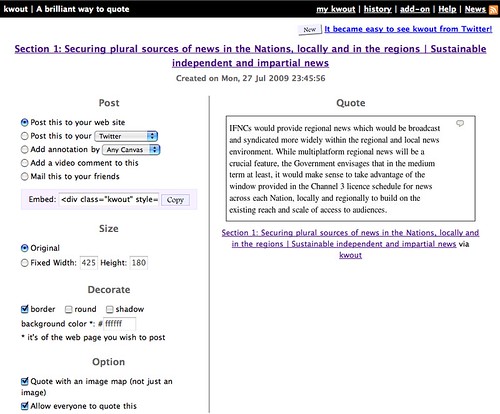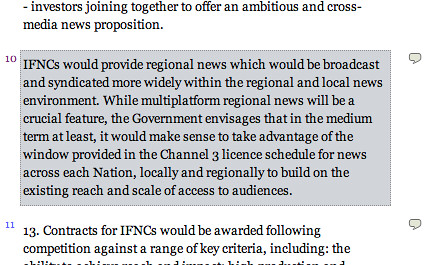One of the things we discussed with respect to embedding WriteToReply/JISCPress quotes in third party applications was whether or not we should support an “imagified” embedding – that is, convert a paragraph to a JPG or PNG image format that can then be easily embedded in the third party site.
The advantage? Even if the third party site disallows script, object or embed tags, it will probably allow img tags…
So for example, extending the range of output formats suggested in Taking the Conversation Elsewhere – Embedded Quotes, we might consider something like an &output=png switch that allows us to construct an image embedding code along the lines of:
<img src=”http://docserver.example.com?p=POSTNUMBER&digress-embed=PARANUMBER&output=png” longdesc=”http://docserver.example.com?p=POSTNUMBER&digress-embed=PARANUMBER”>
Once again, there’s a trackback issue, although it’s easy enough to wrap the image tag in an appropriate anchor tag:
<a href=”http://docserver.example.com?p=POSTNUMBER¶=PARANUMBER”><img src=”http://docserver.example.com?p=POSTNUMBER&digress-embed=PARANUMBER&output=png” longdesc=”http://docserver.example.com?p=POSTNUMBER&digress-embed=PARANUMBER”></a>
However, this facility was seen as non-essential, so I looked on the web for a solution – and found it in the form of the kwout API which can be used to generate an image based representation of text found in a specified div tag (by ID) on a given web page, which can then in turn be embedded in an arbitrary web page. Although the image may be hard to read, this can work to our advantage: it might drive traffic back to the site that originated the quote ![]()
The following javascript snippet uses the Kwwout API to generate an image based representation of a single paragraph from a WriteToReply republished document:
javascript:window.location=’http://kwout.com/grab?address=’+encodeURIComponent(“http://writetoreply.org/pluralnews/2009/07/03/section-1-securing-plural-sources-of-news-in-the-nations-locally-and-in-the-regions/”)+’&block=contentblock_10′
In the API call, “contentblock_10″ is the id of the block element to be quoted. Here’s what the kwouted image looks like:
And here’s the original paragraph on WriteToReply:
Note that the link that the kwout script generates is back to the page in the above case, so to link back to the actual paragraph we’d need to specify this in the link:
javascript:window.location=’http://kwout.com/grab?address=’+encodeURIComponent(“http://writetoreply.org/pluralnews/2009/07/03/section-1-securing-plural-sources-of-news-in-the-nations-locally-and-in-the-regions/#10“)+’&block=contentblock_10′
As a step on the road to full integration (a use of the Kwout API which may or may not be in line with the stated terms and conditions? I don’t know, I haven’t read them…!) is this bookmarklet that should let you highlight a paragraph number on a WriteToReply document, and then take you straight to the Kwout embed page for that paragraph:
javascript:(function(){var l=location.href; window.location=’http://kwout.com/grab?address=’+encodeURIComponent(l)+’&block=contentblock_’+window.getSelection();})()
Actually, that looks a little cluttered, and the usability is a little off. So a better solution maybe to suggest that the user clicks on the paragraph link to get the “paragraph in focus page” page, and then click on the following bookmarklet:
javascript:(function(){var l=location.href;l=l.split(‘#’);window.location=’http://kwout.com/grab?address=’+encodeURIComponent(l[0])+’&block=contentblock_’+l[1];})()
(What this does is pull the paragraph identifier out of the URI and then construct the Kwout API call out of it as a result.)
Or if you want the link to go to the “paragraph in focus” page, rather than the top of the page:
javascript:(function(){var l=location.href;window.location=’http://kwout.com/grab?address=’+encodeURIComponent(l)+’&block=contentblock_’+l.split(‘#’)[1];})()
(Note that neither of these bookmarklets is ideal – a production stable bookmarklet should be able to cope (or fail gracefully) with the lack of hash separated paragraph identifier in the URI.)
Hmm, maybe we need a “labs” area on WriteToReply where we can collect these micro-utilities?

